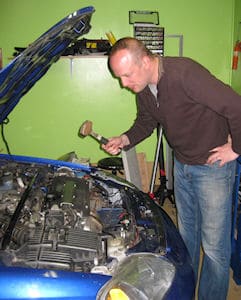
Repairs & Maintenance
In general I, like almost everyone else, really hate dealing with repairs. There is nothing like the sinking feeling after you’ve dropped off your car at a garage to get the service department call informing you of the repair costs. It is amazing how quickly things add up! Unfortunately, with the amount of stress racecars go through, things will inevitably wear down and break. In order to keep maintenance costs down, I strongly advise that you learn how to work on your car yourself (assuming you don’t already know how to). I realize that for some people this may be an intimidating assignment – it was for me. Essentially, the extent of my repair and maintenance knowledge when I began racing was changing the vehicle’s oil. It was a while before I even realized the thought of replacing an axle, or even changing the brake fluid, was beyond me. If you want (or need, as in my case) to keep your racing budget from exploding, you will be forced into learning how to do much of the repair work yourself. After successfully completing a few projects, you’ll realize that accomplishing many of these repairs is not nearly as difficult as one might think. One nice thing about racecar repairs is that you usually have several days before the work needs to be completed, unlike working on a car that is relied upon for everyday transportation. That is, until the racecar decides to break at the track!
Almost all of us have experienced the joys of bringing a car to a garage. After the shop looks at the vehicle, the technician recommends the various parts to be replaced and services to be performed. Frequently these items are not necessary in order to repair the car, but are sold as items that are a part of “normal” maintenance. You also need to keep in mind that the service department representative is typically paid based on the amount of labor hours they sell. The more labor that is involved in the job, the more money the employee and garage makes. Especially in larger garages, an employee is often paid a base salary plus an additional amount on each labor hour sold. It is not uncommon for the base salary to only represent between one-third to one-half of the overall salary. Because of this, the employee is motivated to sell as much work as possible. Parts are another area where garages make money. What is the typical profit margin for parts at a repair shop? It is not uncommon for a garage to add another 40% to 50% to the price that they paid for the part. By all means, not all garages are crooks and out to stick it to you. Garages are businesses with overhead and employees to pay, and they, like all other businesses, do need to make money. Learning to do many of your own repairs will help you better afford your racing habit. Even if you don’t know how to perform all of the necessary repairs yourself, next time you bring the car to a garage at least you’ll sound like you know what you are talking about, and the garage will be less likely to sell you unneeded work. One good question you can ask when having work done by a repair shop is: What work needs to be done in order to resolve the problem itself – what specifically is causing the issue?
 To do the amount of fairly basic maintenance that needs to be completed regularly on a racecar, it would get very expensive quickly if you were to bring the car to the shop each time. I strongly recommend that you buy the factory shop manual for your vehicle. In addition to this manual being very detailed and specific to your car, many clubs such as SCCA require that each participant have a factory shop manual and bring it to the track. The purpose is, if there is a protest over the legality of a car after a race, the steward will be able to refer to this manual for various specifications. If you have difficulty locating a factory shop manual, speak with someone else who races the same vehicle make, or contact a dealer and ask where you can purchase one. Just to forewarn you, factory shop manuals are fairly expensive and often range between $60 and $100. In addition to the official factory shop manual, it will be helpful for you to purchase another repair manual, such as one by Chilton or Haynes. These types of manuals go into further details on how to specifically perform the various types of maintenance and repairs. (These manuals are typically available at automotive parts stores.)
To do the amount of fairly basic maintenance that needs to be completed regularly on a racecar, it would get very expensive quickly if you were to bring the car to the shop each time. I strongly recommend that you buy the factory shop manual for your vehicle. In addition to this manual being very detailed and specific to your car, many clubs such as SCCA require that each participant have a factory shop manual and bring it to the track. The purpose is, if there is a protest over the legality of a car after a race, the steward will be able to refer to this manual for various specifications. If you have difficulty locating a factory shop manual, speak with someone else who races the same vehicle make, or contact a dealer and ask where you can purchase one. Just to forewarn you, factory shop manuals are fairly expensive and often range between $60 and $100. In addition to the official factory shop manual, it will be helpful for you to purchase another repair manual, such as one by Chilton or Haynes. These types of manuals go into further details on how to specifically perform the various types of maintenance and repairs. (These manuals are typically available at automotive parts stores.)
So you may not exactly be a mechanic. A key thing to remember is that the big hammer you have in your tool box should only be used for special occasions! We have all faced situations when the part does not “exactly” fit, and we are tempted to “make it fit” with a little bit of help. If you reach this point, take a break from working on the car for a little while. When you run into roadblocks and are simply unable to figure out how to perform a repair (and inevitably you will), ask for advice and suggestions from other racers. The internet is a very useful tool – use it! Learn what chat forums exist for your vehicle, and become a member. If you are experiencing difficulties in completing a task, search the web site(s) to see if other people have posted information on that topic. If not, create a post asking for advice.
When taking apart more complicated parts, I find it very beneficial to take digital pictures during the process. Take a photo before you do anything to the part(s) you will be working as well as several during the process if necessary. Be sure to take the extra time to clearly label each item as you remove it. By doing this, it will be much easier when you begin reassembling the parts, and wondering “So, how does this get put back together?”
Avoiding Expensive Repairs
Throughout the course of your racing career, things on the car will wear down and break. In most circumstances, you can get what you need by making a trip to your local parts store or salvage yard, or by scanning the internet to see what replacement parts may be available. But at some point, you may be required to make a visit to the dealership for the necessary part. It is amazing how expensive parts from a dealership cost!
During the process of inspecting my Honda Prelude, I realized that the front wheel bearing was worn down and needed to be replaced. I contacted the local parts store, but they stated that it would be necessary to obtain the parts from a dealership. I then made my way to the local Honda dealership and asked how much it would cost for a new bearing.
The employee provided me the cost of the wheel bearing – $97. He added, “Oh, you’ll also need to replace both of the seals, and those are $30.”
“Thirty dollars for two seals?” I replied, in shock.
“No, they are $30 each.”
Ouch! For parts alone, the price was already up to $157 plus tax. Oh yeah, then there is the necessary labor to have the bearing pressed into the hub! While still in shock, I walked over to the service department to obtain the labor cost. The service technician looked up the price and told me it would be $205 plus tax, to which I naively responded, “$205 including the parts?” Nope. “Is that for both sides?” I asked, hoping he mistakenly thought I needed both wheel hubs repaired.
“No sir, that is for one side.”
At that point I was speechless and very depressed about how much this would cost – $362 plus tax. “This is crazy!”
Was there another potential solution? Of course there was! I was so disappointed and frustrated about how much it was going to cost, I e-mailed one of my friends about the ordeal, at which point he simply stated “go to a junk yard and get it.” I contacted a salvage yard (the politically-correct term) and asked how much it would cost for a wheel bearing. He began looking up information on the part and stated that it would be necessary for me to purchase the entire hub assembly, not just the wheel bearing. I waited in anticipation as he searched for the price…”$50 but you need to provide a cash deposit first.” Wow! Fifty bucks? Nice! I dropped off the deposit and picked up the part the next day. I verified that the wheel bearing was in good shape, and that it did not have excessive play. That evening I swapped the hub assemblies, and it has been good ever since.
If you ever do find yourself in a situation when it appears that the repair will be costly, ask other racers for their advice. Maybe they will have another solution that will meet your needs.
A Field Trip to the Home Improvement Store
Take a trip out to some of the home improvement and hardware stores in your area. This may sound a bit silly, but walk down the aisles and try to absorb the various items that they have. Even if while walking down the aisles you don’t recognize a potential use for various items, later in the build and repair processes you may recall having seen things that might be of use. These stores can serve as a great race shop if a person uses a little creativity. One of the hard parts of this trip is to leave the store without buying some of the cool items you see. Resist the temptation unless you really need the item. It is amazing how quickly small ticket items can add up.
